Top 10 Biggest Animals In The World: For as long as humans have existed, animals have lived alongside us. Some of these creatures are tiny and cute, like the little pomeranian that fits right into your palms.
But this article isn’t about the cute little animals that make us feel all fuzzy inside. It is about those creatures that tower above us. The ones that make us look like pomeranians if we are placed next to them. In this article we look at 10 of the biggest creatures that inhabit the earth, from the blue whale that rules the sea to the fearful green anaconda that sends shivers down the spine of the bravest humans. You will learn about their amazing features, their habitats, and their threats.
Recommended: Weakest Animals In The World (With Pictures): Top 12 Laziest
Top 10 Biggest/Largest Animals In The World
1. The Heaviest of them all: The Blue Whale
Type: Aquatic, Mammal
Habitat: Deep Oceans except the Arctic
Weight: Up to 200 tonnes
Length: 82 to 105 feet
Diet: Carnivore (made up almost entirely of krill)
Status: Endangered
Whales are the heaviest living animals. They are so large that humans have not been able to create a scale that can accommodate their entire body all at once. Among this group of heavy beasts, the Blue whale stands out as the heaviest.

The blue whale is so heavy that its tongue weighs as much as an elephant, another animal on our list. If that is not a clear enough picture, a Blue whale’s heart is as big as your car.
A newly born blue whale calf would outweigh most of the animals on this list.
Fun Fact: Asides being the largest animals on earth, these massive creatures are also ranked among the loudest. They also have an extremely long lifespan, with an estimated average of 80 to 90 years.
2. The Largest Land Creatures: The African Elephants
Type: Land Mammal
Habitat:African grasslands, scrub, and forests
Weight: Up to 6 tonnes
Length: 19 to 24 feet
Diet: Herbivore
Status: Endangered
This majestic animal is the stuff of African folktales. With some of the largest African elephants weighing as much as 6 tons and growing as long as 24 feet, it is not surprising that this animal is sometimes referred to as the king of the jungle.

African elephants can be found wandering through 37 African countries. Their massive trunks and tusks make them easily recognizable. These tusks are a result of their ever-growing upper incisor teeth and the trunks help them feed and drink easily. To dissipate excess heat, these creatures use their large fan-like ears.
The African elephants are of two species; the Savanna elephants and the smaller forest elephants. Their names are derived from their respective habitats.
Fun Fact: Elephants are social creatures. They wrap their trunks together as a display of greeting and affection.
Recommended: Features of Hausa/Fulani Pre-colonial Administration
3. The Largest Invertebrate: The Colossal Squid
Type: Cephalopod, Invertebrate
Habitat: Deep Oceans primarily around Antarctica
Weight: Over 1,100 pounds
Length: 39 to 46 feet
Diet: Carnivore
Status: Unknown
The Colossal Squid was once thought to be the stuff of myths. Sailors confessed of seeing gigantic sea creatures that were capable of sinking ships and swallowing sailors whole. While many still doubt these stories, the Colossal Squid may be proof that these myths were based on actual sightings.
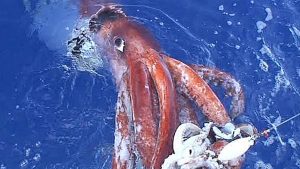
While closely related to the giant squid, the Colossal squid grows longer and instead of just suckers, these creatures also have deadly hooks on their tentacles. These creatures can grow as long as 46 feet and weigh as much as 1,100 pounds. They have a basic diet of fish.
Fun fact: Even though the colossal squid was discovered almost a century ago, very little is still known about it. For one, no one knows how big these creatures can get.
4. The Largest Extant Aquatic Carnivore: The Elephant Seal
Type: Aquatic, Mammal
Habitat: Deep Oceans
Weight: Up to 4.5 tonnes
Length: 10 to 15 feet
Diet: Carnivore
Status: Extant
This aquatic mammal is named after the largest land animal, so it should not be surprising that they are on this list. The elephant seal gets its name because of its size and the large nose of the males which look like a short elephant trunk.

The elephant seal has two species; the bigger southern elephant seal that inhabits the Southern Hemisphere and the northern seal that inhabits areas in the pacific coast of North America.
These creatures feed on deep-sea prey such as squids, eels, and even sharks.
Fun Fact: The large trunk-like proboscis of the male elephant seal also plays sexual purposes. The males also tend to fight for dominance at the start of the mating season.
5. The White Rhinoceros
Type: Land Mammal
Habitat: South Africa, Kenya, Namibia, and Zimbabwe
Weight: Up to 4.5 tonnes
Length: 11 to 14 feet
Diet: Herbivore
Status: Extant
The white Rhinoceros is the largest and the most social of the five rhinoceros species in existence. There are two subspecies of the white rhinoceros, the rare northern white rhinoceros, with only two members left, and the more abundant southern white rhinoceros.

By body mass, the rhinoceros is second only to the elephant as the largest extant land animal. Their sheer body mass alone is enough to earn them a place on this list.
Fun Fact: White Rhinos aren’t actually white. They are grey. Their name comes from a misinterpretation of the word wijd which means wide and was a reference to the size of the creature’s mouth. English-speaking settlers mistook the word for white, hence the name.
See also: Features of Hausa/Fulani Pre-colonial Administration
6. The Hippopotamus
Type: Mammal
Habitat: African rivers and lakes
Weight: Up to 4.5 tonnes
Length: 9.5 to 16.6 feet
Diet: Herbivore
Status: Vulnerable
This scary creature with short limbs is the third largest land mammal. Coming immediately behind the white rhino.
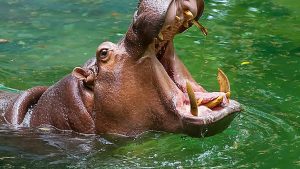
Don’t be fooled by its huge clumsy size, this creature is extremely fast both on land and in the water, where it lives most of its life. It is also extremely unpredictable and dangerous.
Hippos spend at least 17 hours each day submerged in water, after which they climb out and graze on 80 pounds of food each night. This might seem like much, but it is relatively small compared to their body size.
Fun Fact: The smooth grey skin of the hippo secretes a red oily substance that has antibacterial effect and protects them from the sun. This red substance propagated the myth that hippos secrete blood.
7. The Tallest Living Land Animal: The Giraffe
Type: Mammal
Habitat: Woodlands and Savannas
Weight: Up to 2 tonnes
Length: 14 to 19 feet
Diet: Herbivore
Status: Vulnerable
The giraffe isn’t just the tallest land animal, but it is also one of the largest. It is also the largest ruminant on the planet.
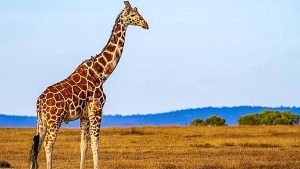
These creatures tend to inhabit woodlands and savannas and depend on leaves, flowers, and fruits of woody plants for nourishment. And their height gives them an advantage that most herbivores don’t have. Although giraffes travel in herds, there are no group bondings as the male tend to fight over and wander between female groups.
Fun Fact: Male giraffes have combat bouts to establish social hierarchies. These bouts are called necking signifying the use of the neck as a weapon.
See also: What Caused World War 1? Main Causes of the First World War
8. The Biggest Living Reptile: The Saltwater Crocodile
Type: Reptile
Habitat: Estuaries and rivers of India, Southeast Asia, and Australia
Weight: Up to 2 tonnes
Length: 9 to 19 feet
Diet: Carnivore
Status: Extant
This creature is as big as it is terrifying. It is particularly aggressive, more so than other crocodile subspecies. It has a reputation for being nasty to humans. Before you think you are safe on land, this creature leaves the water and comes to land to take in the sun’s rays.

Their bites are considered the most ferocious on earth; a fact that is less surprising when you realise that their teeth can grow as long as five inches. This bite, combined with its ability to hold its breath, makes the saltwater crocodile a powerful predator for hunting land animals.
Fun Fact: The saltwater crocodile can inhabit freshwater bodies, despite their name.
9. The Gaur
Type: Mammal
Habitat: South and Southeast Asia
Weight: Up to 1.5 tonnes
Length: 8 to 11 feet
Diet: Herbivores
Status: Vulnerable
The Gaur, popularly referred to as the Indian Bison is probably the largest representation of wild cattle known to man. It is local to Southeast and south Asia.
Male Gaurs are powerful enough to ward off and, sometimes, kill predators, including humans. They typically live in herds of up to 50 bison.
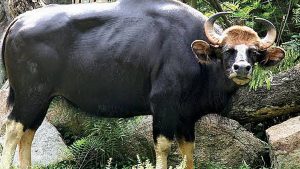
Fun Fact: Bisons used to be populous in Asia, until they were almost hunted into extinction. They have been on the IUCN list of vulnerable animals since 1986.
See also: Advantages and Disadvantages Of a Nuclear Family
10, Leatherback Sea Turtles
Type: Mammal
Habitat: The open ocean
Weight: Up to 1.5 tonnes
Length: 3 to 6 feet
Diet: Carnivorous (Jellyfish)
Status: Endangered
This is the largest reptile after the crocodile. Unlike other turtles, the leatherback sea turtle does not have a bony shell.
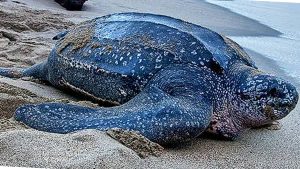
The carapace is covered by a leathery and flexible skin and this is where it gets its name from. Over the years, this majestic creature has seen a decline in population because of poachers who go after them and their eggs.
Every attempt to increase the population of this endangered creature has failed. They keep decreasing and are classified as endangered creatures.
Fun Fact: Leatherback turtles have not evolved since the age of the dinosaurs.